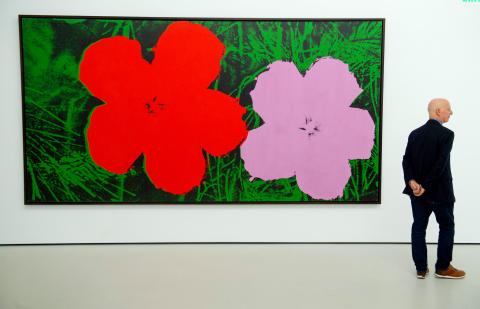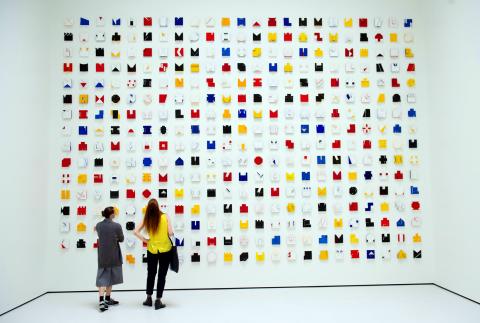It may be the greatest art collection you’ve never heard of — until now.
With a sprawling gallery space opening Thursday in a prosperous exurb of Washington, Glenstone has become one of the world’s biggest private art museums.
At a time when museums are courting Instagram-hungry crowds and visitors have to elbow each other to catch a glimpse, Glenstone has carefully choreographed a journey in the opposite direction as part of its US$200 million expansion.

Photo: AFP
Birdsong and crickets provide the soothing cadence to the 10-minute walk from the parking lot to the new building, along a gravel path carved into rolling hills dotted with wildflowers, sycamore and oak trees.
Split Rocker, a giant flower-covered sculpture by the equally polarizing and famous Jeff Koons is perched atop a hill gazing toward the 204,000-square-foot Pavilions complex.
A water court of aquatic plants ringed by walls of glass provides the beating heart of the Thomas Phifer-designed building, flooded with natural light and shaped with individually poured blocks of gray concrete.

Photo: AFP
The Pavilions’ 11 interconnected structures are embedded into the 230 acres of this former foxhunting estate.
“It’s all very carefully calibrated to allow for that prolonged experience,” said director Emily Rales, 42, who co-founded Glenstone with her husband Mitchell, a 62-year-old billionaire industrialist.
In an interview, she spoke of their “personal quest to find those quiet moments where you can really sit with a work of art and not feel rushed or pressured to move on.”
The setting provides an experience that changes with the seasons and from dawn to dusk in what remains the Raleses’ (tax-exempt) backyard.
Glenstone’s collection of post-World War II art is considered to be one of the best, including works by Louise Bourgeois, Roni Horn and Richard Serra, who has two torqued steel sculptures on the grounds.
In a radical departure from most other museums, the walls are barren of explanatory texts and some rooms have just a single work of art. Gray-uniformed guides, many of them in a young professionals training program, politely engage visitors in discussions about what lies before their eyes.
‘HERE FOR YOU’
Brice Marden’s majestic Moss Sutra with the Seasons (2010-2015) — his only commissioned work — stands alone in a space designed in collaboration with the artist.
Lit through clerestory windows, the painting features four monochrome panels inspired by seasonal colors, while a larger one in the center reveals mossy green calligraphic squiggles typical of Marden’s later years.
A square, skylit room presents On Kawara’s Moon Landing, three large-scale black canvases each indicating in white script a key date during the July 1969 Apollo 11 lunar landing mission.
“We have made this commitment to artists by saying, look, we know that what you’re asking is tremendous and it’s difficult to do, but we’re here for you and we will do whatever we can to realize that vision for you,” said Emily Rales, who studied art history at prestigious Wellesley College before directing New York’s Gladstone Gallery.
“That is very valuable for an artist working today.”
There were 70 meetings with Robert Gober and his studio about his 1992 Untitled installation of large sinks with open taps set against a woodlands wallpaper with barred windows. Newspapers are strewn about the floor.
‘CHAMPION OF THE UNDERDOG’
On the tombstone of Mitchell Rales’ father, a man who rose from a hardscrabble childhood in an orphanage to become a successful businessman, reads the inscription “Champion of the Underdog.”
Glenstone espouses that same motto by presenting works the Raleses dub as “challenging.”
The building’s largest room takes visitors on a trip through art history from 1943 to 1989 with 65 works by 52 artists.
Pulled from Glenstone’s holdings of some 1,300 pieces, they feature many women artists as well as less familiar works.
There’s Abstract Expressionism and Japan’s Gutai, Brazil’s Neo-Concrete, Arte Povera, Minimalism and post-Minimalism. Works by Lygia Clark and Akira Kanayama can be seen near household names like Jackson Pollock and Mark Rothko.
In a separate gallery, visitors can take in a framed view of a hillside while sitting on a softly curved maple bench inviting quiet contemplation at nature’s altar.
Glenstone has been open since 2006, but only received 10,000 visitors in its first seven years using a much smaller space designed by architect Charles Gwathmey. It can now accommodate up to 100,000 people a year, though it is initially limiting visits to 400 per day four days a week, with free online reservations required.

On April 26, The Lancet published a letter from two doctors at Taichung-based China Medical University Hospital (CMUH) warning that “Taiwan’s Health Care System is on the Brink of Collapse.” The authors said that “Years of policy inaction and mismanagement of resources have led to the National Health Insurance system operating under unsustainable conditions.” The pushback was immediate. Errors in the paper were quickly identified and publicized, to discredit the authors (the hospital apologized). CNA reported that CMUH said the letter described Taiwan in 2021 as having 62 nurses per 10,000 people, when the correct number was 78 nurses per 10,000

As we live longer, our risk of cognitive impairment is increasing. How can we delay the onset of symptoms? Do we have to give up every indulgence or can small changes make a difference? We asked neurologists for tips on how to keep our brains healthy for life. TAKE CARE OF YOUR HEALTH “All of the sensible things that apply to bodily health apply to brain health,” says Suzanne O’Sullivan, a consultant in neurology at the National Hospital for Neurology and Neurosurgery in London, and the author of The Age of Diagnosis. “When you’re 20, you can get away with absolute

When the South Vietnamese capital of Saigon fell to the North Vietnamese forces 50 years ago this week, it prompted a mass exodus of some 2 million people — hundreds of thousands fleeing perilously on small boats across open water to escape the communist regime. Many ultimately settled in Southern California’s Orange County in an area now known as “Little Saigon,” not far from Marine Corps Base Camp Pendleton, where the first refugees were airlifted upon reaching the US. The diaspora now also has significant populations in Virginia, Texas and Washington state, as well as in countries including France and Australia.

May 5 to May 11 What started out as friction between Taiwanese students at Taichung First High School and a Japanese head cook escalated dramatically over the first two weeks of May 1927. It began on April 30 when the cook’s wife knew that lotus starch used in that night’s dinner had rat feces in it, but failed to inform staff until the meal was already prepared. The students believed that her silence was intentional, and filed a complaint. The school’s Japanese administrators sided with the cook’s family, dismissing the students as troublemakers and clamping down on their freedoms — with